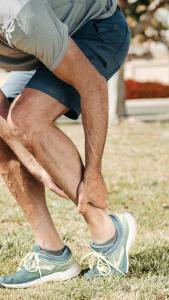Patrick Mahomes, the star quarterback of the Kansas City Chiefs, suffered a high ankle sprain during the 2019-2020 NFL season. This type of ankle injury occurs when the ligaments connecting the tibia and fibula bones are stretched or torn, causing instability in the ankle joint. Unlike a typical ankle sprain, a high ankle sprain can be more severe and take longer to heal, making proper treatment and rehabilitation crucial for a successful recovery.
In this article, we will discuss: the definition of a high ankle sprain, the ligaments involved, how to diagnose the injury, and the fastest way to heal it. We will also cover the importance of rehabilitation and the role of techniques such as dry needling in promoting healing and improving sports performance.
By examining Patrick Mahomes’ experience with a high ankle sprain, we can better understand the impact this injury can have on an athlete’s career and the importance of proper care and rehabilitation.
What is a High Ankle Sprain?
A high ankle sprain is a type of ankle injury that occurs when the ligaments that connect the tibia and fibula bones are stretched or torn. This type of sprain is often more severe and takes longer to heal than a typical ankle sprain, as the ligaments involved are stronger and provide stability to the ankle joint. High ankle sprains are also known as “syndesmotic ankle sprains.”
Importance of Understanding the Recovery Time and Rehabilitation Process

Understanding the recovery time and rehabilitation process of a high ankle sprain is essential to ensure a successful and timely return to sport. A high ankle sprain can take longer to heal compared to a typical ankle sprain, so it is crucial to have a comprehensive understanding of the healing process to ensure proper care and avoid re-injury. The rehabilitation process for a high ankle sprain involves a series of steps to regain strength, flexibility, and stability in the ankle joint. Without proper rehabilitation, the injured ligaments may not heal fully, leaving the individual susceptible to re-injury and potentially longer recovery times.
In addition to reducing the risk of re-injury, proper rehabilitation can also help to improve sports performance. By focusing on strength, flexibility, and stability, rehabilitation can help to restore an athlete’s physical capabilities and reduce the risk of future injury. This can be particularly important for high-level athletes, as a high ankle sprain can significantly impact their career and ability to perform at the highest level.
High Ankle Sprain Diagnosis
Diagnosing a high ankle sprain typically involves a thorough evaluation by a medical professional, who will assess the individual’s symptoms, medical history, and physical condition. The diagnosis process may include several steps, including:
- Physical examination: A doctor will examine the individual’s ankle and foot to assess the extent of swelling, bruising, and tenderness. They may also perform specific tests to determine the stability of the ankle joint.
- X-rays: X-rays may be taken to rule out any fractures and to assess the alignment of the ankle bones.
- MRI: An MRI may be ordered to provide a more detailed image of the ankle and surrounding structures, including the ligaments, bones, and soft tissues.
- Diagnostic injections: In some cases, diagnostic injections may be used to confirm the presence of a high ankle sprain.
Based on the results of these tests, the doctor will determine the extent of the injury and develop an appropriate treatment plan. In some cases, referral to a specialist, such as an orthopedic surgeon, may be necessary to ensure proper diagnosis and care.
Importance of Accurate Diagnosis
Accurate diagnosis is essential for the successful treatment and recovery of a high ankle sprain. A proper diagnosis allows medical professionals to develop an appropriate treatment plan that addresses the specific needs and conditions of each individual. This, in turn, helps to minimize the risk of re-injury and prolonged recovery times.
Inaccurate or delayed diagnoses can lead to improper treatment and can prolong the recovery process. This can also result in further damage to the ankle, which can cause chronic pain and mobility issues. In severe cases, untreated or poorly treated high ankle sprains can even lead to long-term disabilities.
Additionally, accurate diagnosis is critical for the safe return to sport or physical activity. This is especially important for athletes and physically active individuals, as a high ankle sprain can greatly impact their ability to perform at their best.
Tips for Speeding up Recovery
After a high ankle sprain, it is important to start early weight-bearing activities, along with physical therapy and rehabilitation, to promote healing and reduce the risk of chronic ankle instability. Rest and immobilization may not always be necessary, and the best course of treatment will depend on the individual injury and should be determined by a healthcare professional. Physical therapy can help improve range of motion, strength, and balance in the ankle, which can speed up the recovery process.
In addition to physical therapy and rehabilitation, other tips for speeding up recovery from a high ankle sprain may include:
- Compression: Wearing a compression bandage can help reduce swelling and provide support to the ankle.
- Pain management: Over-the-counter pain relievers or prescription medications can help manage pain and reduce inflammation.
- Stretching and strengthening exercises: Gentle stretching and strengthening exercises can help improve flexibility and prevent re-injury.
- Assistive devices: Using crutches or a brace can help reduce the weight placed on the affected ankle, which can speed up recovery.
It’s important to note that every injury is different, and the recovery time for a high ankle sprain can vary depending on the severity of the injury. A healthcare professional can provide personalized advice on the best ways to speed up recovery and prevent re-injury.
Physical Therapy
Physical therapy is an essential part of recovery from a high ankle sprain. The goal of physical therapy is to improve mobility, reduce pain, and prevent future injuries. Physical therapy can also help restore the normal function of the ankle and the surrounding muscles, tendons, and ligaments.
- Physical therapy typically involves a combination of exercises, manual therapy techniques, and assistive devices. Some of the physical therapy techniques that may be used to treat a high ankle sprain include:
- Stretching: Gentle stretching exercises can help improve flexibility and prevent re-injury.
- Strengthening: Strengthening exercises can help improve muscle strength and support the ankle.
- Manual therapy: A physical therapist may use manual therapy techniques, such as massage and joint mobilization, to reduce pain and improve mobility.
- Assistive devices: A physical therapist may recommend the use of crutches or a brace to help reduce the weight placed on the affected ankle.
- Dry Needling: Dry needling is a therapeutic technique that uses thin needles to stimulate the muscles and improve circulation.
Physical therapy can be done in a clinic or at home with the guidance of a physical therapist. It’s important to follow the physical therapy program as prescribed and to continue with the exercises even after the pain has subsided to ensure full recovery and prevent future injuries.
It’s also important to consider the expertise of the physical therapist when choosing a physical therapy clinic. Physical therapists in Scottsdale with specialized training in sports performance and return to sport can provide the best care for athletes with high ankle sprains.
Can You Walk With a High Ankle Sprain?

When it comes to high ankle sprains, walking can be a complicated and challenging activity. One of the first things to consider is the severity of your sprain. In some cases, you may be able to walk with the help of crutches or a walking boot, while in others, you may need to rest completely and avoid putting any weight on your foot.
In general, it’s best to avoid walking if you have a severe sprain, as this can cause further damage to your ankle and extend your recovery time. If your sprain is mild to moderate, however, you may be able to walk with the help of crutches or a walking boot.
Your healthcare provider will be able to advise you on the best course of action, based on the severity of your sprain and the specific needs of your recovery. They may also refer you to a physical therapist, who can help you develop a safe and effective rehabilitation plan.
It’s important to remember that high ankle sprains are complex injuries, and healing time can vary widely depending on factors such as age, overall health, and the severity of the sprain. By working closely with your healthcare provider and following a comprehensive rehabilitation plan, however, you can help ensure a successful recovery and return to the activities you love as quickly and safely as possible.
Precautions to Take When Walking
If you have suffered a high ankle sprain, it is important to take the proper precautions when walking to avoid re-injury or further damage to the affected area. Here are some tips to keep in mind:
- Wear supportive shoes: A stable, supportive shoe can help prevent further injury to the affected area while you walk. You may also consider wearing a brace to provide additional support.
- Use crutches: If your ankle is particularly swollen or painful, using crutches may help take pressure off the affected area and allow you to walk more comfortably.
- Gradually increase activity: Start with short walks and gradually increase the amount of time and distance you walk each day. Over-exerting yourself too soon can lead to further injury.
- Avoid uneven surfaces: If possible, stick to flat, even surfaces when walking to reduce stress on your ankle.
- Stretch regularly: Regular stretching can help improve flexibility and range of motion in your ankle, which is crucial for a full recovery.
It is important to consult with a doctor or physical therapist before attempting to walk on a high ankle sprain to ensure you are taking the proper precautions and not causing further damage. They can also provide guidance on the best treatment options for your specific injury.
Return To Sport Following High Ankle Sprain

Gradual progression is an essential aspect of high ankle sprain recovery, as it allows the damaged ligaments and tissues to heal properly. Going too fast or doing too much too soon can put too much stress on the ankle, causing further injury and prolonging the recovery process.
It is crucial to follow the physical therapy plan prescribed by a healthcare professional, and progress through the exercises and activities slowly and cautiously. This gradual progression allows the muscles, tendons, and ligaments around the ankle to get stronger, providing more stability and reducing the risk of re-injury.
Additionally, allowing the ankle to gradually adapt to weight bearing and impact can also help reduce pain and swelling, promoting quicker healing. Gradual progression can also help improve the ankle’s overall function and flexibility, helping the athlete or individual return to their desired activities and sports performance.
It is essential to listen to your body and take breaks when necessary, as well as to adjust your rehabilitation program based on any discomfort or pain you may experience. Your healthcare professional can help guide you through the process, ensuring a successful and safe recovery.
Physical Therapy for Improving Sports Performance
Physical therapy can play a crucial role in improving sports performance after a high ankle sprain. With the guidance of a licensed physical therapist, individuals can work on regaining strength, flexibility, balance, and stability in the affected ankle. This, in turn, can help them return to sport and perform at their pre-injury level.
Studies have shown that physical therapy interventions such as exercise, manual therapy, and dry needling can help improve outcomes in individuals with ankle sprains.
A study published in the Journal of Orthopaedic & Sports Physical Therapy found that dry needling can be effective in reducing pain and improving function in individuals with ankle sprains. The study suggests that dry needling, when used in conjunction with other physical therapy interventions, can be especially effective in speeding up recovery and improving sports performance.
It’s important to note that each individual’s recovery time and rehabilitation process will be unique and may vary based on the severity of their injury, their age, and other factors. A licensed physical therapist can work with you to create a personalized rehabilitation program that meets your specific needs and helps you return to sport as soon as possible.
When To Consider Returning To Sport
Returning to sport after a high ankle sprain requires a gradual and individualized process. There are several factors that can affect the timing of return to sport, including the severity of the injury, rehabilitation progress, and readiness for sport-specific movements. In general, a return to sport protocol should include the following steps:
- Pain-free movement: Before returning to sport, the individual should be able to perform movements and activities of daily living without pain.
- Progression of strength and balance exercises: The individual should progress from simple to complex exercises to regain strength and stability in the affected ankle.
- Gradual return to sport-specific movements: The individual should start with light activities and progress to more intense and sport-specific movements, such as jumping and cutting, over time.
- Gradual return to full activity: The individual should gradually increase the duration and intensity of activity until they are able to perform at pre-injury levels.
- Monitoring for any signs of reinjury: The individual should monitor for any signs of pain, swelling, or instability and seek medical attention if necessary.
It is important to remember that returning to sport after a high ankle sprain is a gradual process and should not be rushed. The individual should work with a physical therapist or athletic trainer to develop a customized return to sport protocol based on their specific needs and goals.
Painful High Ankle Sprains

Causes of Pain
ain is a common symptom of high ankle sprains, and can occur for a number of reasons. One of the main causes of pain in high ankle sprains is the stretching or tearing of the ligaments and surrounding soft tissue. The high ankle sprain also causes inflammation and swelling, which can put pressure on nerves and cause additional pain.
In some cases, pain may persist even after the initial injury has healed, due to the development of chronic pain syndrome. This can happen if the injury was not treated properly or if there was an underlying issue that was not addressed.
In addition to ligament damage, other factors such as improper rehabilitation or overuse can contribute to the development of pain in the high ankle. It is important to work closely with a healthcare provider or physical therapist to determine the cause of pain and develop a treatment plan that addresses it.
How to Manage Pain
The management of pain in a high ankle sprain can involve various approaches depending on the individual’s symptoms and recovery progress. Some common methods include:
Physical therapy: Working with a physical therapist can help to alleviate pain by strengthening the surrounding muscles, improving flexibility and stability, and promoting proper movement patterns.
Medication: Over-the-counter pain relievers, such as ibuprofen and acetaminophen, can be effective in reducing pain and inflammation. In more severe cases, prescription medication may be necessary.
Assistive devices: Using crutches or a brace can help to reduce weight-bearing stress on the affected ankle, leading to decreased pain.
Dry needling: Dry needling involves the insertion of fine acupuncture needles into specific trigger points to reduce pain and improve function.
Lifestyle modifications: Making changes to one’s daily activities, such as avoiding high-impact exercises or wearing proper shoes, can help to minimize pain and improve recovery.
It’s important to consult a healthcare professional for an individualized pain management plan and to avoid activities that cause pain or discomfort.
When To See a Doctor
Recap of High Ankle Sprain, Recovery Time and Rehabilitation Process

In conclusion, a high ankle sprain is a serious injury that requires proper diagnosis and treatment to ensure a full recovery. The recovery time can vary depending on the severity of the injury, but it typically takes several weeks to several months to heal. The rehabilitation process should include rest, physical therapy, and gradual progression to prevent re-injury and improve sports performance. Pain management techniques can help alleviate discomfort during the recovery process. If you experience persistent pain or difficulty with mobility, it is important to see a doctor. Adhering to a proper recovery protocol and following the guidance of a medical professional can help you return to your sport as soon as possible and reduce the risk of future injury.
Socials
connect with us
Author
Dr. Tyler is a physical therapist and founder Scottsdale Physical Therapy & Performance in North Scottsdale, Arizona. He see golfers, MMA athletes and active adults. His focus is offering one-on-one sessions for 1 hour focused on developing individualized programs to get you back to your goals.
If you have any questions about online programing or want to stop in for a visit, please reach out by hitting “request appointment” in the top of the page.
– Dr. Tyler PT, DPT, FAAOMPT, TPI-2

